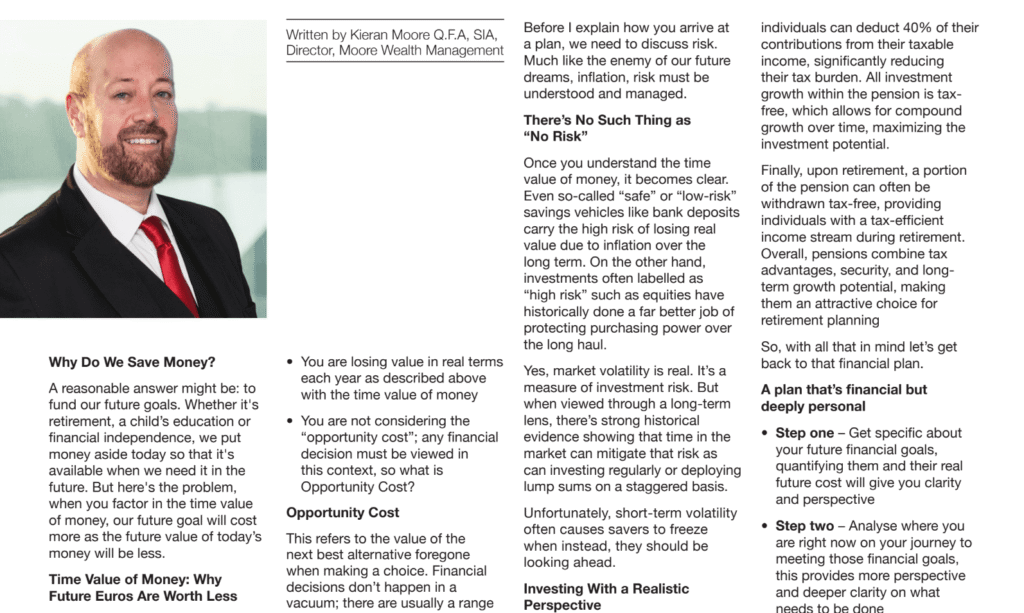Saving and Investing Are Not the Same Thing: Kieran Moore’s Contribution to the Irish Pharmacy News
Kieran Moore, Director of Moore Wealth Management, has once again contributed to the Irish Pharmacy News about the differences between saving and investing, as well as the power of utilising a pension scheme
Many people have never stopped to consider the difference between saving and investing. In fact, some may even disagree with the premise that there is a difference. But if you’re serious about achieving your long-term financial goals, understanding this distinction isn’t just helpful — it’s essential.

Why Do We Save Money?
A reasonable answer might be: to fund our future goals. Whether it’s retirement, a child’s education or financial independence, we put money aside today so that it’s available when we need it in the future. But here’s the problem: when you factor in the time value of money, our future goal will cost more as the future value of today’s money will be less.
Time Value of Money: Why Future Euros Are Worth Less
The time value of money is a fundamental financial principle. It tells us that a euro today is worth more than a euro tomorrow, primarily because money has earning potential over time. And then there’s inflation, the silent dream killer. Inflation steadily erodes the purchasing power of money. What costs €1 today might cost €1.50, €2, or more by the time you need to spend it.
Your Goals Are Getting More Expensive
The truth is that your future goals will likely cost far more than they would today. Unless you have a reliable strategy to keep pace with or ideally outpace inflation, those goals will become harder to reach with each passing year.
This is why, as Financial Planners, we advocate for investing, not just saving.
Saving long-term in low-interest deposits comes with two clear risks
- You are losing value in real terms each year, as described above, with the time value of money
- You are not considering the “opportunity cost”; any financial decision must be viewed in this context, so what is Opportunity Cost?
Opportunity Cost
This refers to the value of the next best alternative foregone when making a choice. Financial decisions don’t happen in a vacuum; there are usually a range of alternatives that can offer a range of other potential outcomes. It is not an abstract notion; it is a real thing that should be a consideration when planning how you save or invest for the future.
It would be rare to see someone elect to put money in an account for 12 months, paying 2.50% if the same bank had another deposit offering paying 3.00% for the same 12 months It would be very clear to you in this situation that you would have an opportunity cost of 0.50% if you took the first option. This does not happen in such a basic way; of course, it’s more complex than that. We are rarely comparing apples with apples in these situations.
So, with all these factors at play, how do we make the right decisions for ourselves? The simple answer is you should not. Expert advice can help, and if done properly, it starts with clearly establishing your financial goals and ends with a plan. Before I explain how you arrive at a plan, we need to discuss risk. Much like the enemy of our future dreams, inflation, risk must be understood and managed.
There’s No Such Thing as “No Risk”
Once you understand the time value of money, it becomes clear. Even so-called “safe” or “low-risk” savings vehicles like bank deposits carry the high risk of losing real value due to inflation over the long term. On the other hand, investments often labelled as “high risk”, such as equities, have historically done a far better job of protecting purchasing power over the long haul.
Yes, market volatility is real. It’s a measure of investment risk. But when viewed through a long-term lens, there’s strong historical evidence showing that time in the market can mitigate that risk as can investing regularly or deploying lump sums on a staggered basis. Unfortunately, short-term volatility often causes savers to freeze when, instead, they should be looking ahead.
Investing With a Realistic Perspective
When evaluating investment options, it’s crucial to look beyond the nominal return (the headline percentage). What really matters is the real return — the return after adjusting for inflation.
If an investment yields 5% annually, but inflation is 3%, the real return is only 2%. That 2% is your true growth in purchasing power. This inflation-adjusted view helps investors make more informed, grounded decisions and ensures their wealth grows, not just in numbers, but in real value.
Pensions are the Ultimate tax-efficient investment vehicle
Pensions are a highly efficient tax-free investment option for many compelling reasons. First, they offer tax relief on contributions, meaning that your company can transfer funds to your pension free of income tax and claim that transfer against corporation tax. In addition, individuals can deduct 40% of their contributions from their taxable income, significantly reducing their tax burden. All investment growth within the pension is tax-free, which allows for compound growth over time, maximising the investment potential.
Finally, upon retirement, a portion of the pension can often be withdrawn tax-free, providing individuals with a tax-efficient income stream during retirement. Overall, pensions combine tax advantages, security, and long-term growth potential, making them an attractive choice for retirement planning.
So, with all that in mind, let’s get back to that financial plan.
A plan that’s financial but deeply personal
- Step one – Get specific about your future financial goals, quantifying them and their real future cost will give you clarity and perspective
- Step two – Analyse where you are right now on your journey to meeting those financial goals. This provides more perspective and deeper clarity on what needs to be done
- Step three – Develop a comprehensive investment strategy that targets funding those future goals, be aware of the time value of money, of real returns and of the opportunity cost of ignoring alternatives when making these decisions. Put risk in context and remember value matters.
- Step four – Invest as tax efficiently as possible, plan for getting all the business-related tax breaks available, and tick all boxes to keep as many options open as possible.
- Step Five– Review the process regularly to make sure your plan stays on track; a lifetime cash flow model can certainly help you keep this process focused.
The Bottom Line
Understanding the relationship between the time value of money and inflation is key to effective financial planning. So the next time you ask yourself Should I invest you already are.
If you’re holding cash in the bank or post office long term, you’re looking at a loss because inflation is eating away at your purchasing power every year.
If you’re unsure how to invest in a way that’s inflation-aware, goal-focused, and evidence-based, talk to someone who can help.
For more information on the differences between saving and investing, contact us today.
Follow us on LinkedIn to keep informed on industry insights, updates and our latest news.


